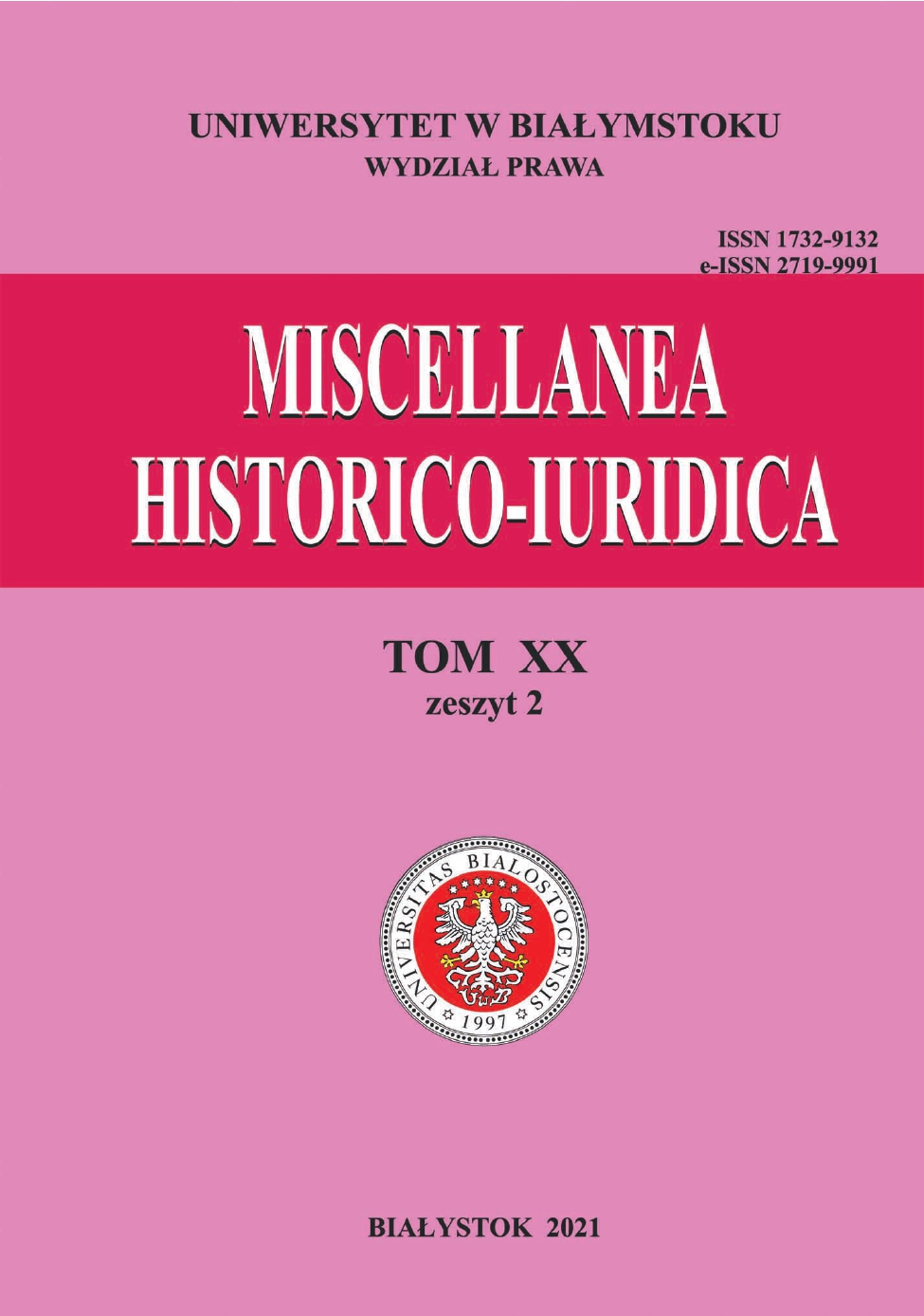Establishment of and Behind the Scenes of the Adoption at the Transitive Act of May 18, 1921 to the Constitutional Act of March 17, 1921 on the Temporary Organization of the Supreme Power of the Republic of Poland
Keywords:
the transitive act, the March constitution, the Constitutional CommissionAbstract
On February 10, 1919, the Legislative Seym met for the first session, whose main goal was to prepare a draft of the basic law for the reborn Poland. Over the next few months, in a specially created constitutional commission, work was carried out to create and submit to the Legislative Seym a draft of a new constitution. However, in order to ensure at least the basic framework for the functioning of the state, on February 20, 1919, a resolution of the Legislative Seym was passed entrusting Józef Piłsudski with the further exercise of the office of the Head of State. This resolution, commonly known as the Small Constitution, was formally in force until June 1, 1921, i.e. the day the March Constitution was announced. Despite the formal repeal of these provisions, they continued to function. In relation to the Seym, the provisions of the Small Constitution were formally in force until November 28, 1922, and in relation to the Head of State until December 14, 1922. However, due to noticing a legislative error in the Small Constitution and in the passing regulations, the provisions of the March Constitution were adopted on May 18, 1921; the Act passed to the Constitutional Act of March 17, 1921 on the temporary organization of the supreme power of the Republic, which “patched up” the incorrectly formulated provisions in the Small Constitution. The work was based on the literature on the Basic Law of 1921, draft laws and amendments presented in the Constitutional Committee, as well as on numerous shorthandings from the sessions of the Legislative Seym, the Seym of the Republic of Poland and the National Assembly.
References
Józef Piłsudski: Pisma zbiorowe, Instytut Józefa Piłsudskiego, t. 5, Warszawa 1937.
Komarnicki W., Ustrój państwowy Polski współczesnej: geneza i system, Wilno 1937.
Krukowski S., Geneza konstytucji z 17 marca 1921 r., Warszawa 1977.
Krukowski S., Konstytucja Rzeczypospolitej Polskie z 1921 r., [w:] Konstytucje Polski. Studia monograficzne z dziejów polskiego konstytucjonalizmu, pr. zbiór. pod red. M. Kallas, t. 2, Warszawa 1990.
Pobóg-Malinowski W., Najnowsza historia polityczna Polski 1914–1939, t. 2, Gdańsk 1990.
Projekt ustawy przechodniej do ustawy konstytucyjnej w przedmiocie tymczasowej organizacji władzy zwierzchniej w Rzeczypospolitej (Druk nr 2703).
Protokół Zgromadzenia Narodowego dla wyboru Prezydenta Rzeczypospolitej Polskiej z dnia 9 grudnia 1922 r.
Protokół Zgromadzenia Narodowego z zaprzysiężenia nowowybranego Prezydenta Rzeczypospolitej Polskiej Gabryela Narutowicza z dnia 11 grudnia 1922 r.
Próchnik A., Pierwsze piętnastolecie Polski niepodległej [1918–1933]: zarys dziejów politycznych, Warszawa 1933.
Sprawozdanie komisji konstytucyjnej w sprawie tymczasowej organizacji władzy zwierzchniej Rzeczypospolitej. Ustawa przechodnia do ustawy o Konstytucji Rzeczypospolitej Polskiej (Druk nr 2706).
Sprawozdanie stenograficzne z 1. Posiedzenia Sejmu Rzeczypospolitej z dnia 28 listopada 1922 r.
Sprawozdanie stenograficzne z 1. Posiedzenia Sejmu Ustawodawczego z dnia 10 lutego 1919 r.
Sprawozdanie stenograficzne z 2. Posiedzenia Sejmu Rzeczypospolitej z dnia 1 grudnia 1922 r.
Sprawozdanie stenograficzne z 221. Posiedzenia Sejmu Ustawodawczego z dnia 17 marca 1921 r.
Sprawozdanie stenograficzne z 227. Posiedzenia Sejmu Ustawodawczego z dnia 18 maja 1921 r.
Sprawozdanie stenograficzne z 3. Posiedzenia Sejmu Rzeczypospolitej z dnia 2 grudnia 1922 r.
Sprawozdanie stenograficzne z 341. Posiedzenia Sejmu Ustawodawczego z dnia 27 listopada 1922 r.
Uchwała Sejmu z dnia 20 lutego 1919 r. o powierzeniu Józefowi Piłsudskiemu dalszego sprawowania urzędu Naczelnika Państwa (Dz.Pr.P.P. 1919 nr 19, poz. 226).
Ustawa przechodnia z dnia 18 maja 1921 r. do Ustawy Konstytucyjnej z dnia 17 marca 1921 r. w sprawie czasowej organizacji władzy zwierzchniej Rzeczypospolitej (Dz.U. 1921 nr 44, poz. 268).
Ustawa z dnia 17 marca 1921 r. - Konstytucja Rzeczypospolitej Polskiej (Dz.U. 1921 nr 44, poz. 267).
Ustawa z dnia 26 września 1922 r. o zasadach powszechnego samorządu wojewódzkiego, a w szczególności województwa lwowskiego, tarnopolskiego i stanisławowskiego (Dz.U. 1922 nr 90, poz. 829).
Ustawa z dnia 28 lipca 1922 r. - Ordynacja wyborcza do Sejmu (Dz.U. 1922 nr 66, poz. 590).
Ustawa z dnia 28 lipca 1922 r. - Ordynacja wyborcza do Senatu (Dz.U. 1922 nr 66, poz. 591).
Ustawa z dnia 8 kwietnia 1919 r. o nietykalności członków Sejmu Ustawodawczego (Dz.Pr.P.P. 1919 nr 31, poz. 263).
Downloads
Published
Issue
Section
License
Copyright (c) 2021 Uniwersytet w Białymstoku (entire issue as a whole); Michał Paweł Stokowski (article)

This work is licensed under a Creative Commons Attribution-ShareAlike 4.0 International License.







